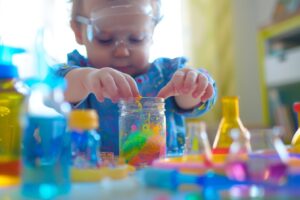Table of Contents
ToggleCrawling, Walking, Talking: Understanding Baby Milestones and What to Expect
Watching your baby grow and develop is one of the most rewarding experiences of parenthood. From the moment they are born, you are eager to see them reach each new milestone, from rolling over to sitting up, crawling, walking, and talking. As a parent, it’s natural to have questions and concerns about your baby’s development, but understanding what to expect at each stage can help ease your worries and provide valuable insights into your baby’s progress.
According to the American Academy of Pediatrics, developmental milestones are a set of functional skills or age-specific tasks that most children can do at a certain age range. These milestones are important markers of a child’s development, and they can help parents and healthcare providers identify potential issues or delays early on. While every baby develops at their own pace, understanding the typical timeline for developmental milestones can be helpful in knowing what to expect and when to seek professional help if necessary.
For many parents, one of the most exciting developmental milestones is crawling. This is often the first time that babies are able to move independently, and it opens up a whole new world of exploration and discovery for them. But when and how do babies typically start crawling? And what can parents do to support this important stage of development?
- Discuss the different types of crawling, such as belly crawling and commando crawling, and the benefits of each.
- Include some tips for creating a safe and stimulating environment for your baby to practice crawling, such as using soft surfaces and providing toys for them to crawl towards.
As your baby continues to grow and develop, there will be many more milestones to look forward to, from taking their first steps to saying their first words. In this article, we’ll explore these important developmental milestones and provide tips and insights on what to expect and how to support your baby’s growth and development along the way.

Crawling: When and How
Crawling is an important milestone in a baby’s development. It’s the first time that they are able to move independently and explore the world around them. But when do babies typically start crawling, and how do they learn to do it?
Most babies start crawling between 6 and 10 months of age, although some may start earlier or later. The exact timing can depend on a variety of factors, including the baby’s strength, coordination, and motivation. Some babies may skip crawling altogether and go straight to walking, while others may crawl for an extended period of time before walking.
There are several different types of crawling, including belly crawling, commando crawling, and traditional crawling on hands and knees. Each type of crawling has its own benefits and challenges, and some babies may prefer one type over another.
- Belly crawling: In this type of crawling, babies use their arms to pull themselves forward while keeping their bellies on the ground. This can help strengthen their upper body muscles and prepare them for more advanced forms of crawling and walking.
- Commando crawling: Also known as army crawling, this type of crawling involves dragging the body forward using the arms while keeping the legs straight. This can be a faster and more efficient form of crawling for some babies, but it may not provide as much upper body strength training as traditional crawling.
- Traditional crawling: This is the classic crawling style that most people think of when they picture a baby crawling on their hands and knees. It can help babies develop coordination, balance, and muscle strength in their arms, legs, and core.
Regardless of the type of crawling your baby prefers, there are several things you can do to help support their development and encourage them to crawl. First and foremost, it’s important to create a safe and stimulating environment for your baby to practice crawling. This means clearing away any potential hazards and providing soft surfaces for them to crawl on, such as blankets or foam mats.
You can also help your baby develop their crawling skills by placing toys just out of their reach and encouraging them to move towards them. This can help motivate your baby to crawl and also improve their hand-eye coordination and depth perception.
If you have concerns about your baby’s crawling development or if they seem to be significantly delayed compared to their peers, it’s important to talk to your pediatrician. They can evaluate your baby’s overall development and provide recommendations or referrals as needed.
In conclusion, crawling is an important developmental milestone for babies and can provide a foundation for more advanced forms of movement and exploration. By understanding the different types of crawling, creating a safe and stimulating environment, and encouraging your baby to practice, you can help support their growth and development during this exciting stage of their life.

Walking: From Cruising to First Steps
After crawling, the next major milestone for most babies is walking. This is a particularly exciting time for parents, as it marks a major step towards independence and mobility for their child. But how do babies learn to walk, and what are the different stages of development involved?
Walking typically begins between 9 and 18 months of age, with most babies taking their first steps around 12 months. However, like crawling, the exact timing can vary widely depending on individual factors such as strength, coordination, and motivation. Some babies may take their first steps earlier or later than the typical range.
Before taking their first steps, most babies will go through a series of stages that involve standing, cruising, and taking small steps with support. These stages are important for building strength, balance, and coordination, and they can take several weeks or even months to complete.
The first stage is standing, which usually begins around 8 to 11 months of age. During this stage, babies will start pulling themselves up to stand using furniture or other objects for support. This can help strengthen their leg muscles and improve their balance and coordination.
The next stage is cruising, which typically begins around 9 to 12 months of age. During this stage, babies will start to take steps while holding onto furniture or other objects for support. This can help improve their balance and coordination, as well as build their confidence and motivation to walk independently.
The final stage is taking first steps, which usually occurs between 9 and 18 months of age. During this stage, babies will take a few tentative steps without support, often towards a parent or other familiar person. These first steps are an exciting milestone for both babies and parents, and can be a sign that more independent walking is just around the corner.
There are several things you can do to help support your baby’s development during these walking stages. Providing plenty of opportunities for standing and cruising, such as setting up a safe and stimulating environment with furniture and objects to hold onto, can help strengthen their muscles and improve their balance and coordination.
You can also encourage your baby to take steps by holding their hands and guiding them along, or by using a push toy or walker to provide support as they move around. These activities can help build your baby’s confidence and motivation to take more independent steps.
It’s important to keep in mind that every baby develops at their own pace, and some may take longer than others to reach these walking milestones. If you have concerns about your baby’s development, it’s important to talk to your pediatrician. They can evaluate your baby’s overall development and provide recommendations or referrals as needed.
In conclusion, walking is an exciting and important developmental milestone for babies that involves several stages of development. By understanding these stages, providing a safe and stimulating environment, and encouraging your baby to practice, you can help support their growth and development during this exciting stage of their life.

Talking: From Babbling to First Words
By the time your baby is around six months old, you may start to hear some random sounds or cooing from them. These sounds are usually vowel sounds or a combination of vowel and consonant sounds, and they are referred to as babbling.
At this stage, your baby is starting to explore their vocal abilities and figuring out how to use their tongue and lips to form sounds. They may also start to mimic sounds they hear around them, such as animal sounds or car noises.
As your baby gets older, their babbling will become more complex and will start to resemble real words. Around the age of one, they may start saying simple words like mama or dada with some meaning behind them.
Here are some tips to help encourage your baby’s language development:
- Talk to your baby often and use simple words and short sentences.
- Repeat sounds and words that your baby makes to encourage them to continue practicing.
- Read books and sing songs to your baby to expose them to different sounds and words.
- Use gestures and facial expressions to help your baby understand the meaning behind the words.
- Avoid using baby talk or dumbing down your speech, as this can actually hinder their language development.
If you have concerns about your baby’s language development, speak to your pediatrician. They may recommend a hearing test or refer you to a speech therapist if necessary.
Remember, every baby develops at their own pace, so try not to compare your child to others. With love, patience, and encouragement, your baby will soon be on their way to talking up a storm!

Other Milestones: Fine Motor Skills, Social and Emotional Development
While crawling, walking, and talking are some of the major milestones in a baby’s development, there are other areas of growth that are equally important to track. These include fine motor skills, social and emotional development, and cognitive development.
Fine Motor Skills
Fine motor skills involve the small muscles in the hands and fingers, which allow for tasks such as grasping objects, picking up small items, and eventually writing. Here are some milestones to look out for:
- Between 2-4 months, your baby will start to grasp objects placed in their hand.
- Around 6-7 months, they may start to transfer objects from one hand to the other.
- Between 8-12 months, they may start using the pincer grasp (using their index finger and thumb) to pick up small items.
- By 18 months, they should be able to stack blocks or other small objects.
- By age 2, they may be able to use a spoon or fork to feed themselves.
Social and Emotional Development
Social and emotional development involves a baby’s ability to interact with others and manage their own emotions. Here are some milestones to look out for:
- By 2-3 months, your baby may start to smile in response to your smile or voice.
- Around 6 months, they may start to show anxiety when separated from you.
- Between 8-12 months, they may start to display stranger anxiety and become shy around new people.
- By 12-18 months, they may start to show affection, such as hugging or kissing.
- By age 2, they should start to understand simple emotions such as happy, sad, and angry.
Cognitive Development
Cognitive development involves a baby’s ability to think, reason, and understand the world around them. Here are some milestones to look out for:
- Between 1-4 months, your baby may start to recognize faces and familiar objects.
- Around 6-7 months, they may start to understand object permanence (the idea that objects still exist even if they can’t be seen).
- Between 8-12 months, they may start to imitate actions and recognize the names of familiar objects.
- By 18 months, they may start to understand simple instructions and follow basic rules.
- By age 2, they may start to engage in pretend play and understand cause and effect.
It’s important to remember that every child develops at their own pace and may hit these milestones at different times. If you have concerns about your child’s development, speak to your pediatrician. They may recommend further evaluation or early intervention services if necessary.

What to Do if You’re Concerned About Your Baby’s Development
As a parent, it’s normal to worry about your baby’s development. While every child develops at their own pace, there are some red flags to watch for that may indicate a developmental delay or issue. If you’re concerned about your baby’s development, the first step is to talk to your pediatrician. They can evaluate your baby’s development and refer you to specialists if necessary.
Here are some signs to watch for:
- Your baby isn’t making eye contact
- Your baby isn’t smiling by three months or isn’t laughing or engaging in social interaction by six months
- Your baby isn’t babbling or making sounds by six months
- Your baby isn’t sitting up by eight months or crawling by one year
- Your baby isn’t walking by 18 months or speaking at least 15 words by two years
- Your baby has lost any previously gained skills or seems to regress in their development
- Your baby seems overly sensitive to certain stimuli or seems unresponsive to others
If your pediatrician does identify a developmental delay or issue, they may refer you to specialists such as speech therapists, occupational therapists, or developmental pediatricians. Early intervention is key, as it can make a significant difference in your baby’s long-term outcomes.
It’s important to remember that every child develops at their own pace and that developmental delays or issues are not a reflection of your parenting skills. The best thing you can do for your baby is to be proactive in monitoring their development and seeking help if you’re concerned.
Conclusion
Understanding your baby’s milestones and developmental stages is crucial in helping them reach their full potential. Remember that each child is unique and will progress at their own pace, but it’s important to keep an eye out for any potential delays or concerns.
By providing a stimulating and nurturing environment, you can encourage your baby to reach their milestones and develop the skills they need for future success. Don’t hesitate to reach out to your pediatrician if you have any concerns about your child’s development. Early intervention can make a huge difference in helping your child reach their full potential.
- Keep track of your baby’s milestones and celebrate their achievements
- Provide a stimulating and nurturing environment
- Stay informed about typical developmental stages
- Don’t hesitate to reach out to your pediatrician if you have concerns
- Remember that each child is unique and will progress at their own pace
Watching your baby grow and develop is one of the most rewarding experiences of parenthood. Enjoy each stage and cherish the precious moments with your little one.
Want to take your knowledge to the next level? Check out these must-read articles:
- The COVID-19 Pandemic and Child Development: How to Support Your Child During These Challenging Times
- The Importance of Nutrition in Baby Development: What to Feed Your Growing Baby
Organize your baby’s wardrobe with our baby clothes closet organizer products! Our organizers are designed specifically for baby clothes. Get your baby’s clothes neat and tidy with our selection of organizers – shop now!
Step into Sue Brown's World of Baby Care, where you'll find a treasure trove of knowledge and wisdom waiting to be explored. Sue's dedication to providing accurate and up-to-date information on baby care shines through in every article, blog post, and resource she shares. From newborn essentials to sleep training tips, breastfeeding advice to nurturing your baby's development, Sue covers a wide range of topics that are essential for every parent to know. Her warm and compassionate approach creates a sense of community and reassurance, making her website a safe haven for parents seeking guidance and support. Let Sue Brown be your partner in this beautiful journey of parenthood, as she empowers you to create a loving, nurturing, and thriving environment for your little one.
- Bubble Wrap Bonanza: Sensory Play for Tiny Fingers - July 22, 2024
- DIY Toddler-Friendly Science Experiments at Home - July 21, 2024
- Treasure Hunt Time: Engaging Toddler Scavenger Hunts - July 20, 2024



